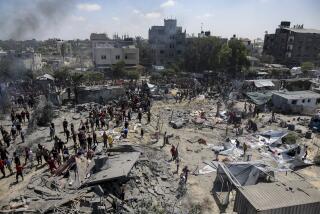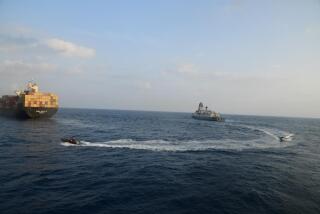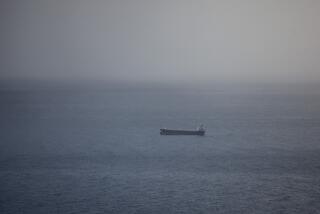Capital Bears Scars of Two-Week War : All Opposition Crushed by South Yemen Rebels
ADEN, South Yemen — The stench of death still lingers in the shuttered streets of the South Yemeni capital, but rebel forces have crushed all opposition by the forces of deposed strongman Ali Nasser Hasani and are now consolidating their authority after the brief but devastating civil war in the Middle East’s only Marxist state.
A new provisional government under interim head of state Haider abu Bakr Attas, who was prime minister under Hasani, is now in full control of Aden and claims to have authority throughout the countryside, including the key province of Abyan, Hasani’s last bastion of support.
The port of Aden, littered with the blackened hulks of sunken vessels, reopened Sunday. By Monday, the first plane-loads of food and medical supplies were arriving from Moscow aboard special Aeroflot fights.
Four reporters, including the correspondent for the Los Angeles Times, were the first foreign journalists to reach Aden in the wake of the fighting. After a three-day crossing of the stormy Gulf of Aden from the east African nation of Djibouti in a 35-foot yacht, we covered the last six miles in a rubber dinghy, spending Monday night on the water when denied permission to land. Permission to go ashore was granted Tuesday.
There we found a capital still bearing the scars of nearly two weeks of fierce fighting that was touched off, according to authoritative sources here, when Hasani tried to eliminate his political opponents in a preemptive attack Jan. 13.
Casualties have been too many to count, but the number of dead is believed by local observers to exceed 12,000. The bodies have been buried in two mass graves, but the stench of rotting flesh still pervades many areas of the city.
“It was hell. The shells and bullets were coming in from everywhere,” said a South Yemeni port official who asked not to be identified by name.
Troops and turbaned tribesmen patrol the largely deserted streets, flashing victory signs at one another and supervising the slow work of removing the debris of war--the twisted hulks of tanks and armored personnel carriers, the burned-out cars and trucks, the rubble of bombed buildings and thousands of spent shell casings.
The area around the port of Aden, known as Steamer Point, has been almost entirely destroyed. A Panamanian tanker, the Cosmos, lies on its side half under water. It was sunk in the harbor by the crossfire of a fierce battle between rebel tanks and naval gunboats loyal to Hasani.
Australian Yacht Sunk
Another tanker was badly damaged, and an Australian yacht, ironically named the Innocent Bystander, was also sunk.
The Steamer Point area, the site of government offices and a naval base, was the scene of some of the heaviest fighting, although the port facilities themselves remain intact. Most of the shore-side buildings, however, have been reduced to rubble. Thick slicks of oil from two damaged storage tanks coat the streets.
Teams of workers are spreading sand on the oil and hauling off the hundreds of damaged vehicles. Shops are slowly starting to reopen while armed patrols check the identities of motorists at scores of roadblocks throughout the city.
Red Cross Arrives
Efforts to restore water, electricity and other essential services are continuing. A four-member team from the International Committee of the Red Cross arrived from Djibouti on Tuesday with a ton and a half of medical supplies.
Local officials, speaking strictly on the condition of anonymity, gave the first authoritative accounts of how the fighting started and the reasons behind it. They also said that about 1,200 foreigners remain in Aden after the evacuation of most foreign nationals to Djibouti by British, French and Soviet ships last week.
Those who stayed behind include about 1,000 Indian oil refinery workers, some Soviet and Arab diplomats and 12 Filipino hotel workers who said they had no money to leave.
A Move for Ouster
According to the local officials and several neutral sources, the fighting erupted in the morning of Jan. 13 after Hasani, fearing a move to overthrow him, called a meeting of the 11-man Politburo and tried to execute four of his chief rivals.
When the Politburo members arrived at the central committee headquarters in the Steamer Point area, presidential guards opened fire on them, killing the first deputy prime minister, Ali Ahmed Antar, and a former defense minister, Saleh Muslih Kassem, the sources said.
Former strongman Abdul-Fattah Ismail, who returned from five years in exile in Moscow last fall, was wounded in the arm while Ali Salem Bedd, minister of local affairs, escaped injury, according to the sources.
Just before the shooting, senior officers loyal to Hasani began rounding up other commanders known to be supporters of Antar and “just mowed them down in their barracks,” one authoritative source said.
The fighting spread quickly after that as the military divided and armed tribesmen loyal to the various factions controlled by their kinsmen descended on the capital from the surrounding hills, the sources said.
“The president (Hasani) had the senior officers but had almost no support among the middle and lower ranks,” one source said. “Ali Antar’s supporters also had the tanks and the rocket forces, and around the third or fourth day, these proved to be decisive,” turning the battle in favor of the rebels.
The source said that Hasani apparently planned his preemptive strike much earlier because “sacks full of pamphlets denouncing Ali Antar and Ismail for plotting a coup” were later found by the rebels.
Underestimated Resistance
However, “(Hasani) apparently underestimated the resistance and the reaction to the barracks massacres,” the source added. “If he had just killed the politicians, he might have gotten away with it. But the fighting spread quickly when they started executing commanders at the lower levels because then everybody had to fight desperately to survive.”
While this version of events could not be independently confirmed, it reinforced the impression of diplomats and other neutral observers that the fighting spread spontaneously, taking the Soviet Union, which maintains a large military and diplomatic presence here, by surprise.
While Hasani and his rivals are all Marxists, Antar and Ismail apparently took a harder line. They reportedly were strongly opposed to Hasani’s efforts to improve relations with some of the pro-Western Arab states such as Saudi Arabia.
In the beginning, Moscow seemed to support Hasani, but when his forces quickly began to crumble in the city, the Soviets tried to avoid taking sides, diplomats said. The Soviet Embassy was shelled and badly damaged by Hasani forces in apparent retaliation for Moscow’s lack of support, local officials said.
Authoritative sources added that Moscow is supporting the new government, now that it appears to be firmly in control.
The composition of the new government, however, is still not clear. Attas, who was in India and then flew to Moscow when the fighting erupted, returned Sunday to head the the new government in line with an agreement secured by Moscow among the rebel factions.
However, he is described by one knowledgeable source as being a “compromise interim figure” while the new government, referred to simply as the “collective leadership,” is being formed.
“There was quite a lot of killing and destruction and these people are now regrouping and trying to organize themselves into a government again,” the source said.
Hasani Still Missing
Hasani’s whereabouts have not been confirmed, but Mohammed Hubaishi, a senior Foreign Ministry official, denied rumors that he is in the Abyan region regrouping his forces.
Hubaishi took reporters on a tour of Zinjibar, Abyan province’s capital, on Wednesday to show them that the new government is firmly in control of the area.
The reporters were also shown a prison where 150 political opponents of Hasani were said to have been machine-gunned to death in their cells Jan. 15 and then buried in a mass grave.
Local officials in Abyan said Hasani arrived there on the morning of his unsuccessful preemptive strike and stayed two days before fleeing to neighboring Yemen. They said they believe that he is in that country now.
The governor of Abyan, Ali Ahmed Mohammed, is reported to have fled. His whereabouts are unknown as are those of Ahmed Musad Hussein, chief of the state security forces, who also fled. The two men were said by the Foreign Ministry official to have been the chief architects of the attempt to wipe out the key Politburo members.
The Foreign Ministry official said the interim government is now trying to bring together the Central Committee, whose surviving members are scattered, in order to elect a new Politburo, after which the line-up of the new leadership should become clearer.
More to Read
Sign up for Essential California
The most important California stories and recommendations in your inbox every morning.
You may occasionally receive promotional content from the Los Angeles Times.










